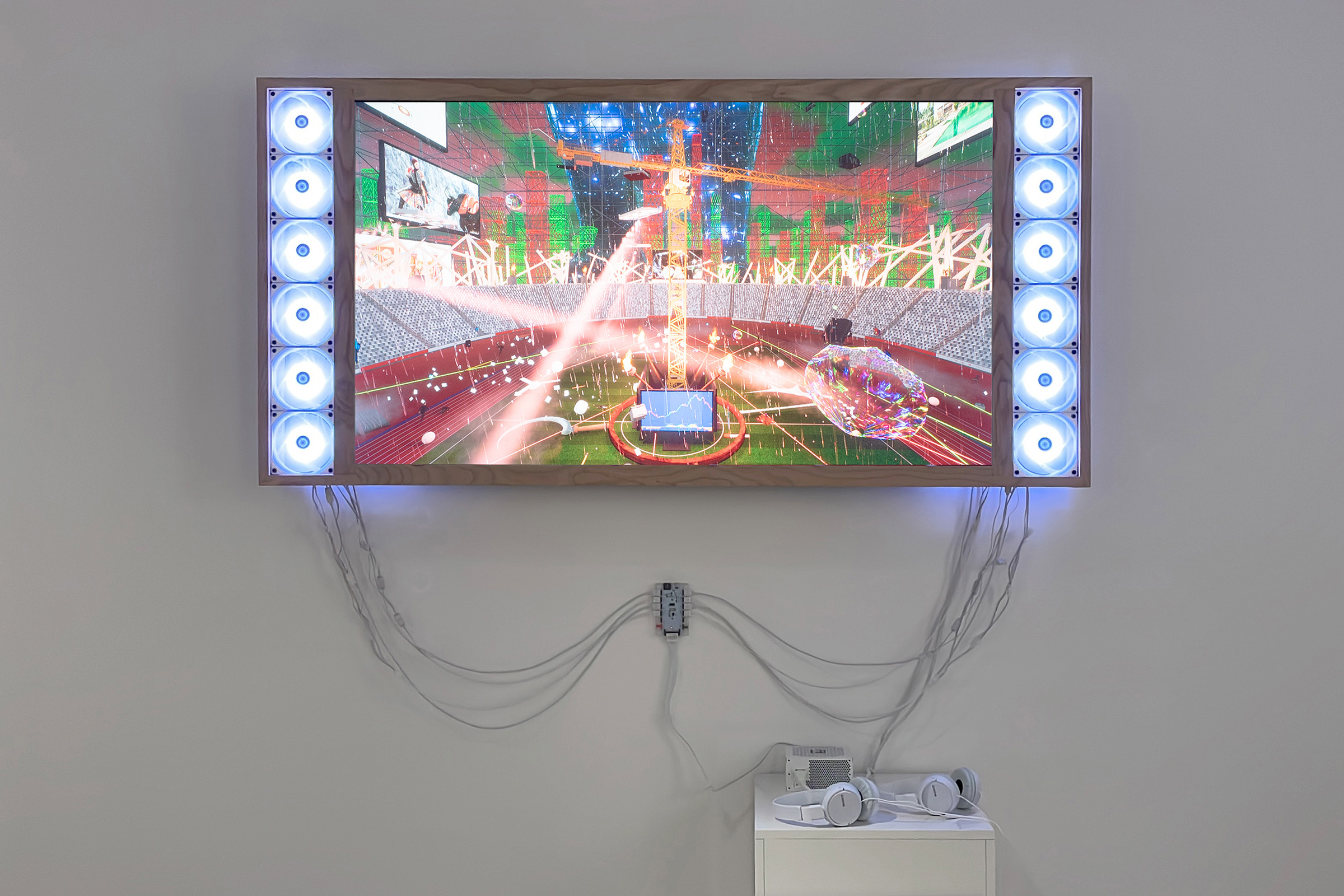<矩阵模型与上层建筑>,2019-2023,实时模拟

(installation shot)
Artist - Rui Hu
Simulation Scripting - Rui Hu
Deep Learning and Data Analysis - Susan Yingshu Chen
screenshorts 截图:










Statement:
A few years ago, when I was touring the Suzhou Creek on a rainy night in Shanghai, several young individuals in business suits rushed past me in haste. One of them accidentally dropped a stack of papers. He yelled, “Wait!” while frantically collecting the scattered documents. This scene left a lasting impression and became the visual foundation for the work. "Matrix Model and Uberbau" (2023) is a real-time game-based simulation using image and text to reflect on the synchronicity between the evolution of artificial intelligence and computer graphics technology, and the fluctuations of financial markets. The year 2008 stands as a stark symbol in this narrative—a time when economies globally were ravaged by crisis following a period of deceptive prosperity, with especially devastating impacts on the stock and housing markets. The Shanghai Stock Exchange Index climbed to an all-time high, before plummeting from well over six thousand points to under two thousand just months before the Beijing Olympics. In the United States, the financial market crash rooted in the subprime mortgage crisis revealed the vulnerability and unfairness of Wall Street. Amidst this economic turmoil, Nvidia unveiled CUDA, making general-purpose computing on the Graphics Processing Unit (GPU) streamlined and accessible. Traditionally used to produce images rooted in military and entertainment, GPU has since infiltrated numerous domains including AI, scientific computing, and finance, due to its prowess in parallel computing and matrix operations. My work reflects on this history, with various scripted events in the simulation driven by “predictions” of the 2007-08 Shanghai Stock Exchange Index using a deep learning neural network trained on the first-generation consumer GPUs with CUDA support. The frantic activities taking place in a space half sports stadium and half construction site are observed from automatically switched viewpoints and accompanied by the voices of Hong Kong comedian Wong Tze-wah joking about financial and housing markets and an AI-cloned Zizek discussing graphics technology and ideology. The work asks: could the widespread adoption of advanced deep learning, powered by computer graphics apparatus, equip us with the foresight into disasters previously unforeseen, or will it only further bolster the hollow self-perpetuating nature of finance capitalism? This question cascades into multiple subtopics—basic needs versus desires; the notion of "model" in graphics, sciences, and economics; the emotions and psychology in housing and stock market; the uncertainty and violence of life; and the paradoxical thought that the only perfect model might be the one that embrace its inherent inaccuracy.
几年前的一个雨夜,我走在苏州河边,几个穿着西装的青年从我身边匆匆跑过。其中一人不小心掉了一叠文件。他边喊着:“等等!”边忙乱地收集散落一地的纸张。后来我经常会回想起这个场景,于是它成为了作品的视觉基础。《矩阵模型与上层建筑》(2019-23)以实时游戏程序模拟探索人工智能与计算机图形技术的交织演变,以及与金融市场波动之间的共时性。 2008 年是这一叙事中的重要节点——全球经济在经历了一段虚假的繁荣后,危机突然降临。上海证券交易所指数先是攀升至历史最高点,随后在奥运会开幕的几个月前崩塌,从六千点跌至两千以下。在美国,源于次级抵押贷款危机的严重股灾也暴露了华尔街的脆弱与不公。经济动荡的前后,英伟达 (Nvidia) 公司推出了 CUDA平台,使通用计算在图形处理单元 (显卡,或GPU) 上得到普及。 过去,显卡通常是游戏玩家或视觉娱乐产业关注的设备,但在此后,由于显卡擅长并行计算和矩阵运算,逐渐成为基于机器学习的人工智能的硬件基础,进入科学与经济等众多领域。作品反思这段历史,使用在第一代支持CUDA通用计算平台的消费级显卡上训练的深度学习神经网络,对 2007-08 年的上证指数进行分析和“预测”,以驱动模拟中的各种行为与事件。自动切换的摄像机视角展示着竞争和暴力的同时,语音也会随之切换:香港喜剧演员黄子华讲述关于股票交易和住房市场的笑话,人工智能生成的齐泽克讨论着从资本主义到游戏等话题,以及上海话的股市数据播报交织在一起。 由计算机图形设备带动的深度学习的普及,是否能让我们对以前无法预见的灾难获得先见之明?或者,这种技术是否只会进一步强化金融资本主义空洞的自我延续的本质?作品围绕这些问题展开——基本需求与欲望;图形学、科学和经济学中的“模型”概念;房地产市场和股市中的情绪与心理;生活的不确定性与暴力;以及一种矛盾的认知:唯一完美的模型,可能只会是那些拥抱自身不准确性本质的模型。
Screen recording excerpt 录屏片段: